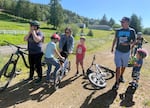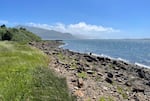Tillamook County has long been known as Oregon’s dairy capital. More than a million people visit the local creamery each year. Its products can be found in grocery stores nationwide.
Within the next decade, however, something else could bring people here in droves: mountain biking.
The U.S. Forest Service is in the final stages of approving a vast new mountain biking trail system near Sandlake, an unincorporated community between two popular coastal state parks, Cape Kiwanda and Cape Lookout.

The Sandlake area, pictured here, includes lush forests, sea cliffs, sand dunes and a sprawling estuary. The U.S. Forest Service is in the final stages of approving a mountain biking system here that could draw large amounts of people. Locals fear it could overwhelm the area's residents and environment. Others believe this is the ideal place to mountain bike year-round.
Bryce Dole / OPB
The plan for now: 23 miles of new trails, eight miles of roads converted to trails, a three-acre skills park and four parking areas. Construction could take years to complete, project proponents say. A forest service spokesperson said it could take a decade.
The project’s supporters say this system would be the ideal place to mountain bike year-round, fueling the region’s economy and providing a way for people — young people, particularly — to connect with nature.
“I want my grandkids to be able to go ride this place someday, and I think we can all agree on that,” said Ron Baker, secretary of the Tillamook Off-Road Trail Alliance, a local nonprofit spearheading the project. “But we gotta do it right.”
Not everyone’s optimistic. Some Sandlake locals say this area is already overrun with tourists, and that it lacks the resources and infrastructure to manage more.
“During the height of the season, it’s just going to be a constant user conflict,” said Adam Rasmussen, a resident of Sandlake, about a 20-minute drive from Tillamook. “It’s going be a traffic nightmare. I just don’t see how it works.”

Members of the Tillamook Off-road Trail Alliance gear up to ride mountain bikes on June 7, 2024, behind the Nestucca K-8 School in southern Tillamook County near Cloverdale. The group is trying to build a vast mountain biking system in the nearby Sandlake area. They say they have been working with the U.S. Forest Service for years, developing plans to ensure the system won't ruin the area.
Bryce Dole / OPB
Thousands of people flock here, one of the state’s most scenic stretches of coastline near Pacific City, to fish, hike, camp, surf and ride dune buggies. It’s home to a variety of wildlife, including elk and deer, and critical habitat for the northern spotted owl, which is threatened, and the marbled murrelet, which is endangered. (A forest service spokesperson said the project includes measures to avoid impacting the birds’ habitat.)
The tension the proposed mountain biking system has created is similar to those facing rural communities across the American West. And the local debate raises a broader question: Can recreation and tourism be the new economic backbone of communities that were once supported by logging and timber?
Tourism drives Tillamook County
In addition to the dairy industry, logging mills were once the economic backbone of Tillamook County’s communities. But about three decades ago, the industry crumbled. Mills shut down. Many people lost their jobs.
“To fill the void, tourism has really moved into Tillamook County,” said County Commissioner Doug Olson.
A multi-million dollar industry, tourism is now an economic lifeline in Tillamook County. It’s the second-largest financial contributor to the county’s road department, Olson said. In 2013, voters approved a tax on room rentals, and in the following decade, annual revenue surged in unincorporated areas like Sandlake.

Tillamook County's scenic coastlines draw thousands of visitors each year. Some people say tourism is an essential part of the region's economy. Others say it places a burden on the county's limited resources.
Bryce Dole / OPB
Business owners and employees in downtown Tillamook say they can’t survive without the rush of visitors during the warmer months. Some are excited about the prospect of new mountain bikers coming to the area, especially after the pandemic shuttered some businesses.
“I think it’ll be huge,” said Brittany Naegeli, who works at an art gallery downtown. “I think it will be a really big step in the right direction for Tillamook County, because there’s so much of this county that is dying off without tourism.”
But Olson says tourism also places a burden on the county’s limited resources, including roads and public safety. He noted that, under the state’s transient lodging tax, 30% of the revenue generated can go toward county services, while 70% must go back toward supporting tourism itself.
“That’s one of the big issues with tourism,” Olson said. “Do they pay their way? The answer is: probably not. But they do bring jobs.”
Joanie Schmidgall, a public affairs officer with the Siuslaw National Forest, said in an email that the Forest Service doesn’t know how much the project will cost. Schmidgall said the project would “likely be funded by a combination of grants and volunteer work.”
Olson supports the idea of a new mountain biking system, but only if it’s managed well.
“I can see the possibility that you bring in more people for whatever reason — good reasons — that overwhelm the system,” said Olson, adding “And not everybody hauls out his own trash.”
Growing pains
On a recent sunny day, Rasmussen drove his silver pickup truck up a steep dirt road through the lush forest near his home in Sandlake. He passed two elk, parked his car, hiked up a hill and reached a point with stunning views: Sea cliffs. Sand dunes. A sprawling estuary. The Pacific Ocean.
“I think you can kind of see what their vision is here,” he said. “It’s perfect.”
A mountain biker himself, Rasmussen used to support the prospect of a trail near his home. Now he feels differently. In May, he was among a group of 30 people who signed a letter to the Forest Service, urging federal regulators to reassess the project’s potential impacts and how many people might use the trail system.
Schmidgall, the spokesperson, said the Forest Service is doing that.

This provided map depicts the proposed mountain biking trail system that is in the final stages of approval by the U.S. Forest Service, located in the Sandlake area near Cape Kiwanda and Cape Lookout.
Courtesy of U.S. Forest Service
“We aren’t arguing over what a lot in the Forest Service want to call a trivial trailhead in the middle of an unknown forest,” said Rasmussen, who noted that other mountain biking trail systems in Oregon draw hundreds of thousands of people each year. “It’s a massive undertaking.”
In the view of some Sandlake locals, the Forest Service and the project’s proponents aren’t making thorough plans for what’s to come. Already, they say, ambulances fly up and down the area’s single road during the summer. There’s no cell phone service. Traffic can be overwhelming.
“I know what it’s going to be like,” said Buck Miller, who lives on Sandlake Road at the foot of the proposed system. “It’s going to be worse than it is now.”
His wife, Kathleen Miller, agreed. Over the past 10 years, she said she has seen the area become a recreation destination, with the sounds of nearby dune buggies echoing into their home. In December, she noted, a landslide covered Sandlake Road, between Tierra Del Mar and Pacific City, closing it for about three months and leaving area residents with one exit road. Like others, she’s concerned about how locals will manage with even more people.
“I see a big change coming,” said Kathleen Miller, adding: “You’re not going to change progress. You just gotta make sure you’re prepared for it. And we’re not down in Tillamook County. At all.”
Connecting to the coast
The Nestucca Valley School District, in southern Tillamook County near Sandlake, has about 550 students enrolled. Behind the school is a large mountain biking skills course.
Misty Wharton, the school superintendent, is not a mountain biker herself. But as a lifelong resident who has seen this region change, she is willing to embrace that evolution. In fact, she plans to build a five-mile mountain biking trail to connect the local K-8 building to the high school, and further trails after that.

Eleanor Baker, left, and Taj Fields, right, ride mountain bikes on June 7, 2024, behind the Nestucca K-8 School, which is part of the local school district in southern Tillamook County near Cloverdale. Supporters of a proposed nearby mountain biking system hope it will help connect young people with nature.
Bryce Dole / OPB
“I think that we’re at the point in that transformation where we don’t have the infrastructure we need yet,” she said. “And so it can be a little bit scary to those that are living here, because it’s happening so quickly.”
Wharton and other supporters of the project acknowledge there will be significant challenges as the region morphs into a bicyclists’ destination. But they say it could provide significant economic benefits to the area, creating jobs and connecting youths with the environment.
“I think more access to trails for kids is one of the best things we can do for them,” said Baker, of the mountain biking non-profit.

Young mountain bikers ride a skills course on June 7, 2024, behind the Nestucca K-8 School, part of the school district in southern Tillamook County near Cloverdale. Local bikers and officials hope to see the county become a popular destination for bikers.
Bryce Dole / OPB
As Baker and other nonprofit members stood beside the course on a recent day, their kids whirred by on mountain bikes. They argued that mountain bikers are often mindful of taking care of natural spaces. They said they have taken years to plan the project thoroughly and that building it would occur in phases, giving them enough time to make sure it’s done carefully.
“We’re stewards of this area,” said Baker. “This area has a deep meaning to all of us, and we don’t want to see it get ruined.”
He added, “We get that there’s neighbors down below that this is going to have an impact on. We want to minimize that as much as we can.”
Schmidgall, the spokesperson, said the Forest Service doesn’t have a firm timeline for its final decision on the project, but noted it could take months.
